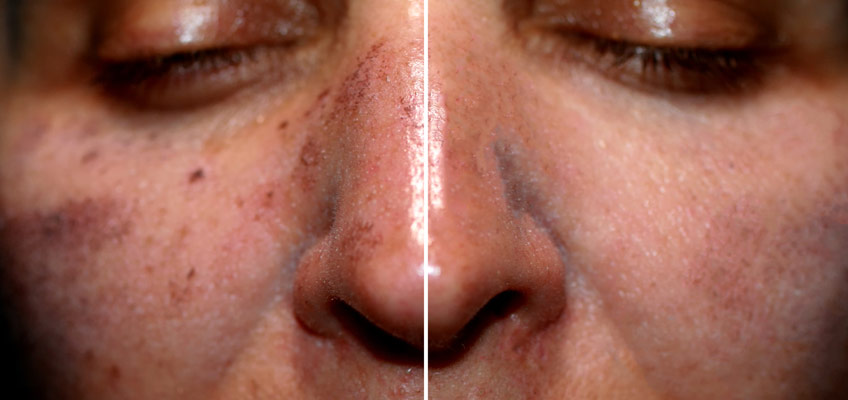
What are sunspots and sun damage?
Sun spots, also known as age spots, are brown or black, flat spots that develop on the skin when the skin is exposed to the sun’s ultraviolet (UV) rays. On the face, hands, and arms, where the skin is frequently exposed to the sun, they are more prevalent. Sun spots are usually painless and harmless, but some people worry about how they look.
On the other hand, the term “sun damage” is used to describe the damaging effects that ultraviolet (UV) rays from the sun can have on the skin. Over time, UV exposure can result in a variety of skin issues, including:
- Sunburn: An intense response of the skin to extreme UV Redness, pain, and sometimes blistering are all signs of sunburn.
- Ageing prematurely: UV rays have the potential to prematurely age the skin, resulting in wrinkles, fine lines, and sagging
- Skin cancer: Skin cancer, which is the most prevalent form of cancer, is primarily brought on by exposure to ultraviolet (UV)
- Uneven complexion: Melanin, the pigment that gives skin its color, can be produced more rapidly in response to ultraviolet (UV) light. As a result, your skin may appear unevenly toned, with areas of lighter and darker
It is essential to protect your skin from the sun by wearing protective clothing, applying sunscreen with a high SPF, and avoiding prolonged exposure to the sun during peak hours in order to prevent sun damage, sun spots, and other skin conditions.
How can I treat sunspots and sun damage?
Sun spots can be treated in a variety of ways, depending on their size, location, and severity. The following are some common treatments for sun spots:
- Applying creams: Sun spots can be reduced over time with prescription or over-the-counter creams containing hydroquinone, retinoids, and vitamin C. These creams lighten dark spots by either inhibiting melanin production or increasing cell turnover.
- Chemical peels: During a chemical peel, a solution is applied to the skin, causing the outer layer to peel off, revealing skin that is smoother and more radiant underneath. Chemical peels can be used to treat sun spots, but only a trained professional should perform
- Laser treatment: Sunspots are broken down by focused light energy during laser therapy, allowing the body to naturally remove them over time. Although laser therapy is typically safe and effective, it can be costly and may require multiple
- Cryotherapy: The sun spot is frozen in liquid nitrogen during cryotherapy, which eventually causes the spot to peel Cryotherapy is a speedy and somewhat modest choice, yet it tends to be awkward and may cause brief redness and rankling.
It is essential to keep in mind that, despite the fact that these treatments have the potential to treat sun spots, they do not address the root cause of sun damage. Wearing protective clothing, applying sunscreen with a high SPF, and avoiding prolonged exposure to the sun during peak hours are all important ways to shield your skin from the sun and prevent sun spots from returning.
How can hydroquione help treat sunspots and sundamage?
When applied topically, hydroquinone works by inhibiting the enzyme tyrosinase, which is involved in the production of melanin. It works by decreasing the creation of melanin in the skin, which reduces skin pigmentation by lightening dark spots and diminishing the appearance of sun damage.
Hydroquinone is ordinarily utilized as a momentary treatment for sunspots and different types of hyperpigmentation, and is frequently joined with different ingridents, for example, retinoids and L-ascorbic acid for ideal outcomes.
Hydroquinone should only be used under a health care professionals supervision because prolonged use can cause skin irritation and other side effects. To stop further sun damage, it’s also important to keep up good sun protection habits like wearing sunscreen and staying out of the sun for too long.

How can Enlighten Pico Genesis help treat sunspots and sundamage?
The non-invasive Enlighten Pico Genesis laser treatment uses picosecond laser technology to improve the appearance of sun damage and sun spots on the skin.
Discoloration-causing pigment in the skin is the target of the treatment, which breaks it up.
The skin’s melanin absorbs the laser’s energy, causing the pigment to break up into smaller pieces that the body’s immune system naturally removes. Sun spots and other forms of hyperpigmentation are reduced and new, healthy skin cells are encouraged to grow as a result of this procedure.
Enlighten Pico Genesis also has the added benefit of encouraging the production of collagen in the skin. This can help to smooth out the texture of the skin as a whole and lessen the appearance of wrinkles and fine lines.
What to expect after treating your sunspots and sundamage with a pico genesis treatment?
When using Pico Genesis to treat sunspots, you may notice some slight redness and swelling in the treated area. These symptoms usually go away within a few hours. During the treatment, some patients may also experience a slight tingling or prickling sensation, which is usually well-tolerated and goes away quickly.
Throughout the following couple of days, you might see that the sunspots obscure and show up more recognizable. This is a typical piece of the treatment interaction, as the laser energy makes the shade ascend to the outer layer of the skin. However, the darkened pigment will begin to peel off over the next one to two weeks, revealing skin that is clearer and has a more even tone.
To get the best results, most patients will need multiple treatments spaced several weeks apart. The severity of the sunspots, in addition to other factors like age and skin type, will determine the exact number of treatments required.
To maintain the results of the treatment and prevent further sun damage, it is essential to continue practicing good sun protection habits, such as wearing sunscreen and avoiding prolonged sun exposure.
To book your complimentary consultation appointment, call us at 416-548-6548 Book a Consultation
